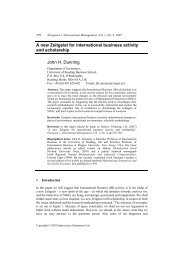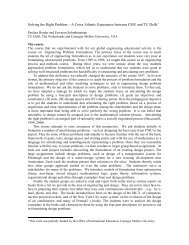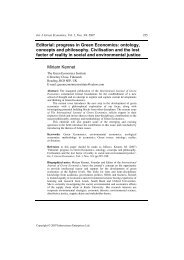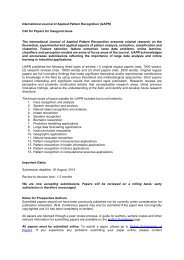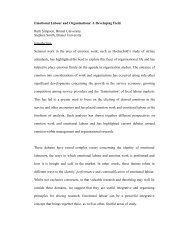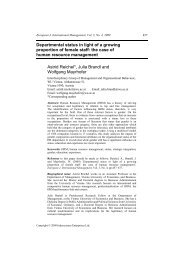The boundary of a shape and its classification
The boundary of a shape and its classification
The boundary of a shape and its classification
Create successful ePaper yourself
Turn your PDF publications into a flip-book with our unique Google optimized e-Paper software.
Figure 5. A <strong>shape</strong> x, <strong>its</strong> <strong>boundary</strong> b(x) <strong>and</strong> two possible neighborhoods ∆(b(x))<br />
coequal to x.<br />
Figure 6 illustrates this provision for a line <strong>shape</strong> to be a sub<strong>shape</strong> <strong>of</strong> the <strong>boundary</strong><br />
<strong>of</strong> a plane segment. Neighborhoods ∆ 1 (l) <strong>and</strong> ∆ 2 (l) are necessarily disjoint, since<br />
∆1 ( l ) ≤ x ∧ ∆<br />
2<br />
( l ) ⋅ x = 0 ⇒ ∆1<br />
( l ) ⋅ ∆<br />
2<br />
( l ) = 0. We note that every <strong>shape</strong> is a<br />
neighborhood <strong>of</strong> <strong>its</strong> <strong>boundary</strong>. We can now state the condition that suffices for a<br />
<strong>shape</strong> to be a sub<strong>shape</strong> <strong>of</strong> the <strong>boundary</strong> <strong>of</strong> a segment:<br />
(4) Any sub<strong>shape</strong> <strong>of</strong> the <strong>boundary</strong> <strong>of</strong> a segment is also a sub<strong>shape</strong> <strong>of</strong> the <strong>boundary</strong><br />
<strong>of</strong> any other segment that contains the given segment provided there is a<br />
neighborhood coequal <strong>and</strong> disjoint from the latter segment.<br />
∀ , y ∈ Σ , x ≤ y : ∀l<br />
≤ b(<br />
x ) : l ≤ b(<br />
y ) ⇔ ∃∆(<br />
l ) : ∆(<br />
l ) ⋅ y = 0.<br />
x<br />
seg<br />
Figure 6. A sub<strong>shape</strong> l <strong>of</strong> the <strong>boundary</strong> b(x) <strong>of</strong> a segment x <strong>and</strong> two neighborhoods<br />
∆ 1 (l) <strong>and</strong> ∆ 2 (l) coequal to x.<br />
By comparing a neighborhood <strong>of</strong> a segment with any <strong>shape</strong> coequal with this<br />
neighborhood it follows that:<br />
(5) A segment <strong>and</strong> each <strong>of</strong> <strong>its</strong> neighborhoods can always be partitioned, with respect<br />
to any other <strong>shape</strong> coequal to the neighborhood, into two <strong>shape</strong>s <strong>and</strong> corresponding<br />
neighborhoods one contained in the second <strong>shape</strong> <strong>and</strong> the other disjoint from it.<br />
∀l ∈ Σseg , ∀∆(<br />
l ), ∀x<br />
∈ Σ : c ( x ) = c ( ∆(<br />
l )) ⇒ ∃∆(<br />
m),<br />
∆(<br />
l − m)<br />
: ∆(<br />
l ) = ∆(<br />
m)<br />
+ ∆(<br />
l − m)<br />
∧ ∆( m ) ≤ x ∧ ∆(<br />
l − m)<br />
⋅ x = 0.<br />
Figure 7 illustrates this proposition for a pair <strong>of</strong> plane segments.




